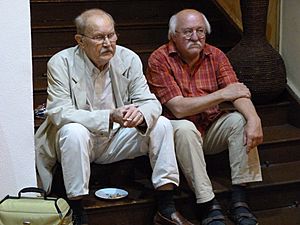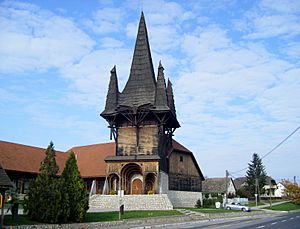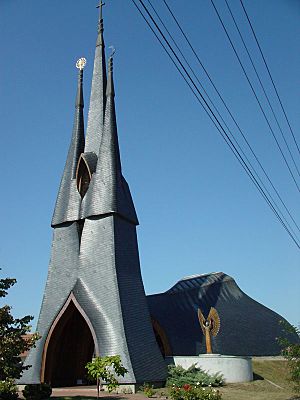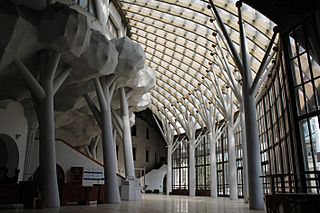Imre Makovecz facts for kids
Quick facts for kids
Imre Makovecz
|
|
|---|---|
| Born | November 20, 1935 |
| Died | September 27, 2011 (aged 75) |
| Nationality | Hungarian |
| Alma mater | Technical University of Budapest |
| Spouse(s) | Marianne Szabó |
| Children | 3 |
Imre Makovecz (born November 20, 1935 – died September 27, 2011) was a famous Hungarian architect. He worked in Europe from the late 1950s until his death.
Makovecz was born and passed away in Budapest, Hungary. He studied at the Technical University of Budapest. He was also the founder and leader of the Hungarian Academy of Arts. He won many important awards for his work, including the Ybl Prize and the Kossuth Prize.
Contents
What is Organic Architecture?
Imre Makovecz was a big supporter of something called organic architecture. This means his buildings were designed to fit in with nature. They looked like they grew out of the ground, rather than being placed on top of it. He was inspired by architects like Frank Lloyd Wright and Rudolf Steiner. He also used ideas from traditional Hungarian art.
His early work was a way to show his thoughts about the way buildings were made during the communist era. Back then, many buildings looked the same. After 1989, when communism ended, his buildings started to comment on how the world was becoming more global. He wanted his buildings to connect with Hungarian history and culture.
Famous Buildings by Imre Makovecz
Makovecz designed many unique buildings. Here are some of his most well-known projects:
- The Cultural Center in Sárospatak (finished in 1982).
- A Sports Hall in Visegrád (built in 1985).
- The Town Hall and Commercial Center in Dunajská Streda.
- The Community Center in Kakasd (completed in 1996).
- He and his team designed buildings for the Pázmány Péter Catholic University campus in Piliscsaba.
- He designed the Hungarian pavilion for the World Expo in Seville, Spain in 1992.
- A special house in Recsk.
Other Important Projects
Imre Makovecz worked on many other interesting buildings throughout his career:
- Restaurants in places like Berhida (1964), Velence (1965), and Szentendre (1973).
- The Funeral Chapel at Farkasréti Cemetery (1975).
- Tourist lodges and a camping complex in Visegrád (1977-1978).
- Cultural centers in Jászapáti (1983) and Szigetvár (1985).
- Churches in Siófok (1986) and the Holy Spirit Church in Paks (1987).
- The Secondary School in Sárospatak (1988).
- An Ecological Centre in Überlingen, Germany (1989).
- The Theatre and Hungarian Community Center in Lendava, Slovenia (1991–2004).
- The Stephaneum building in Piliscsaba (1995).
- The OnionHouse Theatre in Makó (1995).
- A Swimming Pool in Eger (2000).
- The Roman Catholic Church in Miercurea Ciuc, Romania (2001).
- The Pancho Arena in Felcsút (2014), which was finished after he passed away.
Gallery
See also
 In Spanish: Imre Makovecz para niños
In Spanish: Imre Makovecz para niños












